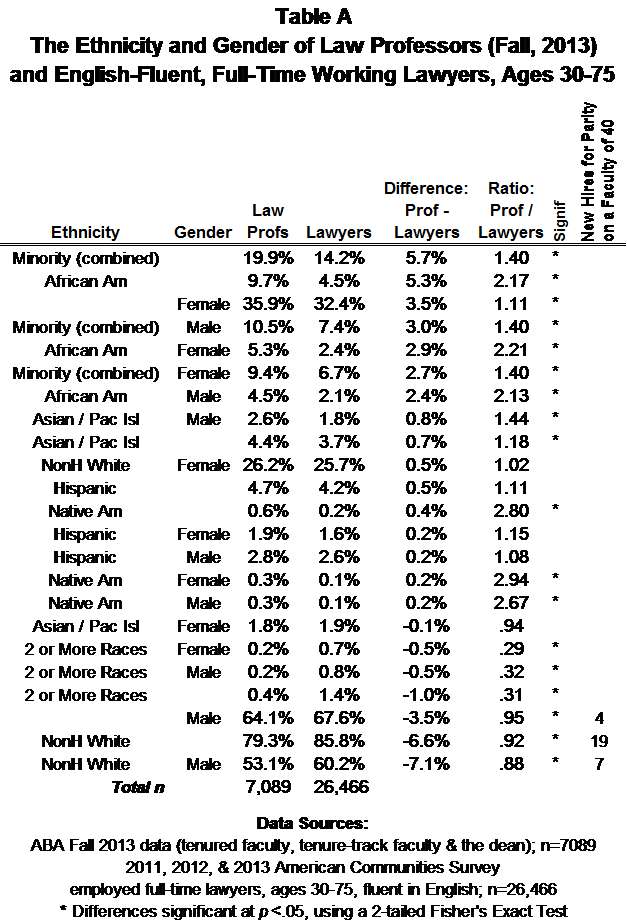The Volokh Conspiracy
Mostly law professors | Sometimes contrarian | Often libertarian | Always independent
Law faculty diversity: Successes and failures
How diverse are tenured and tenure-track law faculties? Which ethnic and gender groups are now the most under- and over-represented in law teaching compared to a very broad measure of the pool: English-fluent, full-time working lawyers of a similar age?
In "Measuring Diversity: Law Faculties in 1997 and 2013," which can be downloaded from SSRN, I explore tenure-track law school diversity in 1997 and 2013. For the gender and ethnicity of law professors in 2013, I use data released by the ABA, representing the 2013-2014 academic year. For the lawyer population, I use data from the government's 2011-2013 American Communities Surveys.
This study finds that diversity hiring in law schools has been a great success, at least as to ethnicity and gender. All large traditional affirmative-action groups in law teaching are now at or above parity with full-time lawyers, and such groups as women, minorities, and minority women are significantly over-represented in law teaching compared to working lawyers. Indeed, the only ethnic and gender groups that are more than a half slot short of parity on a typical tenure-track faculty of about forty are non-Hispanic whites, males, and non-Hispanic white males, the groups typically thought of as over-represented.

Table A is a shortened version of Table 17 in the Measuring Diversity paper. It ranks groups from the most over-represented to the most under-represented in law teaching compared to working lawyers, ranked by the absolute percentage above or below parity. By that measure, all ethnic minorities combined are the most over-represented group in law teaching (19.9% of professors compared to 14.2% of lawyers). That corresponds to about two extra minorities on a typical law faculty of forty. Next are African Americans (5.3% over-represented), followed by females (3.5% over-represented, only about one extra women on each faculty of forty). As the ratio column shows, there are over twice as many African-American law professors as their percentages among working lawyers would suggest.
The most under-represented ethnic or gender group in law teaching compared to working lawyers is non-Hispanic white males, who are about three faculty short of parity. If, however, a faculty were to do targeted hiring of only white males without firing any current faculty, they would need to hire seven white males on every faculty to reach parity. To reach parity for non-Hispanic whites overall, every law faculty of forty would have to hire nineteen whites. The third most under-represented group by absolute percentage differences is males overall (3.5% short of parity).
By ratios the most under-represented groups in Table A are those who report "2 or more races," though the ABA schools might underuse that category for professors one of whose races includes white. In any event, people of multiple races are not even a half a slot short on a typical faculty of forty.
For comparisons to larger general populations and for details on the data and analyses, see "Measuring Diversity: Law Faculties in 1997 and 2013." (The analysis for lawyers in the general population is limited to those fluent in English because that limitation becomes important in the rest of the SSRN paper when comparisons are made between law professors and the overall full-time working population. Because less than 1% of working lawyers are not fully fluent in English (and most of these are non-Hispanic whites), if lawyers who are not fluent in English were added, the results would change little: the percentage of Hispanics would rise 0.1% to 4.3% and of Asian/Pacific Islanders would rise 0.2% to 3.9%. For more details on how the numbers in Table A were generated, see the Afterword in my SSRN paper.)
* * *
In terms of race and gender, law faculties are now as diverse as the English-fluent, full-time working lawyer population of a similar age. To make further progress on this front, perhaps one should focus more on ethnic and gender equity within the leadership of law faculties and on diversifying the population of working lawyers to widen the pool from which professors are drawn. Moreover, traditional diversity hiring of women and ethnic minorities does not necessarily lead to a diversity of viewpoints - and regarding political views, usually leads in the opposite direction.
If as a society we are to engage in social engineering, we need to pay more attention to realities and to think more critically about what we are actually accomplishing. We should study our success with affirmative action to learn how it can be exported to other fields, but we should also study our failure to promote diversity of viewpoints to learn how to reverse it. Now that the important work of race and gender integration has succeeded on law school faculties - with the traditional affirmative action groups now matching or exceeding their percentages in the broader lawyer population - the next step should be to desegregate law schools politically.
To get the Volokh Conspiracy Daily e-mail, please sign up here.


Show Comments (0)